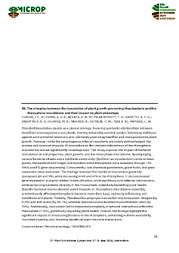The interplay between the inoculation of plant growth-promoting rhizobacteria and the rhizosphere microbiome and their impact on plant phenotype.
The interplay between the inoculation of plant growth-promoting rhizobacteria and the rhizosphere microbiome and their impact on plant phenotype.
Author(s): CUNHA, I. C. M.; REINA, A. V. S.; BOLETA, E. H. M.; PELLEGRINETTI, T. A.; ZAGATTO, L. F. G.; ZAGATTO, S. S. S.; CHAVES, M. R.; MENDES, R.; PATREZE, C. M.; TSAI, S. M.; MENDES, L. W.
Summary: Microbial inoculation stands as a pivotal strategy, fostering symbiotic relationships between beneficial microorganisms and plants,thereby enhancing nutrient uptake, bolstering resilience against environmental stressors, and ultimately promoting healthier and more productiveplant growth. However, while the advantageous roles of inoculants are widely acknowledged, the precise and nuanced impacts of inoculation onthe intricate interactions of the rhizosphere microbiome remain significantly underexplored. This study explores the impact of bacterialinoculation on soil properties, plant growth, and the rhizosphere microbiome. By employing various bacterial strains and a synthetic community(SynCom) as inoculants in common bean plants, the bacterial and fungal communities in the rhizosphere were assessed through 16S rRNA andITS gene sequencing. Concurrently, soil chemical parameters, plant traits, and gene expression were evaluated. The findings revealed thatbacterial inoculation generally decreased pH and V%, while increasing H+Al and m% in the rhizosphere. It also decreased gene expression inplants related to detoxification, photosynthesis, and defense mechanisms, while enhancing bacterial diversity in the rhizosphere, potentiallybenefiting plant health. Specific bacterial strains showed varied impacts on rhizosphere microbiome assembly, predominantly affectingrhizospheric bacteria more than fungi, indirectly influencing soil conditions and plants. Notably, Paenibacillus polymyxa inoculation improvedplant nitrogen (by 5.2%) and iron levels (by 28.1%), whereas Bacillus cereus boosted mycorrhization rates (by 70%). Additionally, inoculationled to increased complexity in network interactions within the rhizosphere (~15%), potentially impacting plant health. Overall, the findingshighlight the significant impact of introducing bacteria to the rhizosphere, enhancing nutrient availability, microbial diversity, and fosteringbeneficial plant-microbe interactions.
Publication year: 2024
Types of publication: Abstract in annals or event proceedings
Unit: Embrapa Environment
Keywords: 16S rRNA, Common bean, Feijão, ITS, microbial ecology
Observation
Some of Embrapa's publications are published as ePub files. To read them, use or download one of the following free software options to your computer or mobile device. Android: Google Play Books; IOS: iBooks; Windows and Linux: Calibre.
Access other publications
Access the Agricultural Research Database (BDPA) to consult Embrapa's full library collection and records.
Visit Embrapa Bookstore to purchase books and other publications sold by Embrapa.

